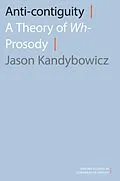A recent wave of research has explored the link between wh- syntax and prosody, breaking with the traditional generative conception of a unidirectional syntax-phonology relationship. In this book, Jason Kandybowicz develops Anti-contiguity Theory as a compelling alternative to Richards' Contiguity Theory to explain the interaction between the distribution of interrogative expressions and the prosodic system of a language. Through original and highly detailed fieldwork on several under-studied West African languages (Krachi, Bono, Wasa, Asante Twi, and Nupe), Kandybowicz presents empirically and theoretically rich analyses bearing directly on a number of important theories of the syntax-prosody interface. His observations and analyses stem from original fieldwork on all five languages and represent some of the first prosodic descriptions of the languages. The book also considers data from thirteen additional typologically diverse languages to demonstrate the theory's reach and extendibility. Against the backdrop of data from eighteen languages, Anti-contiguity offers a new lens on the empirical and theoretical study of wh- prosody.
Autorentext
Jason Kandybowicz is Associate Professor of Linguistics at The Graduate Center, City University of New York. He specializes in the syntax of West African languages and has published extensively on a variety of topics in formal syntax, field linguistics, and the syntax-phonology interface. He is the author of The Grammar of Repetition: Nupe Grammar at the Syntax-Phonology Interface (2008) and co-editor of Africa's Endangered Languages: Documentary and Theoretical Approaches (OUP 2017).
Inhalt
List of Abbreviations Used in Non-Cited Data Acknowledgments Map of Languages Covered in This Book Chapter 1: Introduction Chapter 2: Prosodic Entanglement and the Anti-Contiguity of Wh & C. BChapter 3: An Anti-Contiguity Approach to Tano In-Situ Interrogative Distribution Chapter 4: An Anti-Contiguity Approach to Nupe Interrogative Distribution Chapter 5: Anti-Contiguity Cross-Linguistically References.
